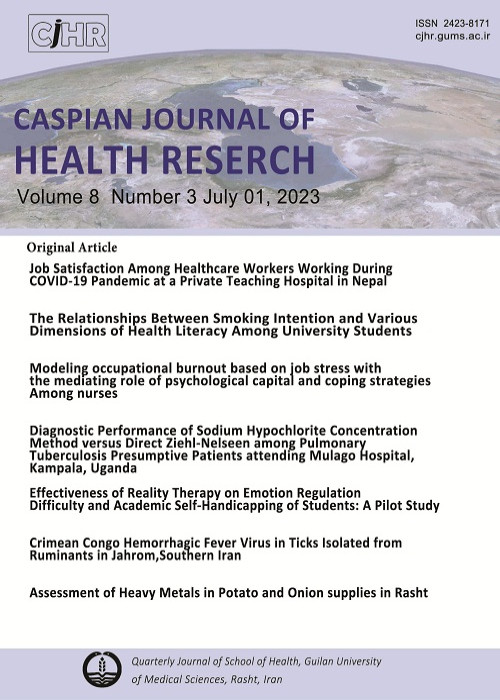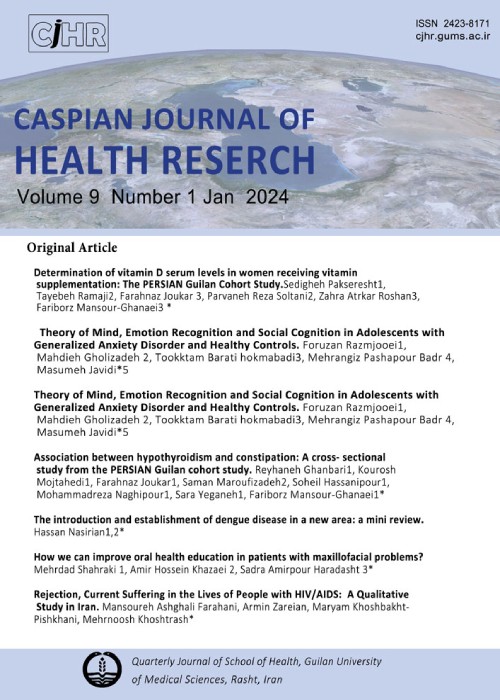فهرست مطالب

Caspian Journal of Health Research
Volume:8 Issue: 3, Jul 2023
- تاریخ انتشار: 1402/05/10
- تعداد عناوین: 7
-
-
Pages 129-135Background
COVID-19 pandemic has created many serious challenges to the frontline workers in their day-to-day job activities. Job satisfaction among healthcare workers is most predominant component to smooth functioning of institutional activities and to improve the quality of patient care.
ObjectiveTo find out job satisfaction among frontline healthcare workers during COVID-19 pandemic.
MethodsA cross-sectional study was conducted among 228 healthcare workers (doctors and nurses) working in Chitwan Medical College Teaching Hospital (CMC-TH) during the COVID-19 pandemic. A simple random sampling technique was used to select the sample and a self-administered structured questionnaire with a job satisfaction scale was used to collect the data. Obtained data were analyzed in SPSS version 20 for Windows using descriptive and inferential statistics.
ResultsThe majority (71.1%) of the healthcare workers were ambivalent whereas few (18%) were satisfied, and 11.0% were dissatisfied with their job during the COVID-19 pandemic. Healthcare workers' median percentage satisfaction score was higher on the domains of coworkers (70.8%), nature of work (70.8%), and supervision (70.8%) whereas lower on fringe benefits (54.2%), and contingent rewards (54.2%) other domains. There was a statistically significant association between job satisfaction level with age (p=0.037), marital status (p= <0.001) and experience (p=0.016) of the doctors and nurses.
ConclusionsJob satisfaction is very low among healthcare workers in a teaching hospital. Hence, appropriate strategies are needed to be implemented considering the identified domains of satisfaction to enhance the healthcare workers’ job satisfaction and quality patients’ care.
Keywords: Job satisfaction, COVID-19, Healthcare workers -
Pages 137-142Background
Cigarette Smoking plays an important role in causing chronic diseases around the world and its consumption among adolescents is quickly increasing. Significant relationship has been reported between the smoking status and health literacy.
ObjectiveThis investigation aimed at recognizing the relationships between smoking intention and various dimensions of health literacy in university students.
MethodsIn the current cross-sectional investigation, 542 students of Mashhad Universities of Applied Sciences were collected using cluster sampling method. Data collection tools were sociodemographic, health literacy, and smoking intention questionnaire. Data were analyzed through SPSS software.
ResultsAmong the various investigated dimensions of health literacy, the decision making and health information application dimension has the lowest score and the reading skills and access dimensions have the highest score, respectively. Results showed that the smoking intention was associated significantly with decision making (ß Standard: -0.27, Confidence interval: -0.03 - -0.01) and health information application and access dimensions (ß Standard: -0.3, Confidence interval: -0.03 - -0.02). Furthermore, decision making and health information application dimension was the strongest smoking intention predictor.
ConclusionRecognizing the skills that are most strongly associated with smoking decision-making can help designers develop clear, informative, and actionable programs and training. The findings of this investigation indicated the fact that in order to reduce the intention of smoking and in contrast to increase carrying out preventive and healthy behaviors among university students, specific consideration must be had to the factor of health literacy and its effective dimensions.
Keywords: Health literacy, smoking intention, University Students -
Pages 143-150Background
Occupational burnout is one of the factors that can significantly decline the performance of nurses, and can be influenced by various factors.
ObjectivesThe present study seeks to model occupational burnout based on job stress with the
mediation of psychological capital and coping strategies used by nurses.Materials & MethodsThe present correlational article falls into the category of descriptive-crosssectional studies. The population of the study includes all nurses working in public hospitals of Kermanshah province. A total of 404 nurses selected through random cluster sampling participated in the study. Demographic Information Questionnaire, Nursing Stress Scale, Maslach Burnout inventory, The Coping Inventory for Stressful Situations and psychological capital questionnaire were used for data collection purposes. The collected data were analyzed using SPSS software, version 24 and Amos software, version 24.
ResultsThe results showed that the proposed model had an acceptable goodness of fit (χ2/df=3.05, GFI=0.90, CFI=0.93, RMSEA=0.07). The results suggest that occupational stress with the mediating role of problem -focused coping (β=0.028, P=0.001), emotion-focused coping (β=0.069, P=0.001), avoidant-oriented coping (β=0.046, P=0.001) and psychological capital (β=0.144, P=0.001) can indirectly affect nurses’ occupational burnout.
ConclusionJob stress affects nurses’ burnout directly as well as through the mediation of problem-focused coping, emotion-focused coping, avoidant-oriented coping and psychological capital. Accordingly, authorities are advised to organize training courses to improve coping strategies and psychological capital of nurses and thereby mitigate the effect of occupational stress.
Keywords: Coping strategies, Job stress, Nurses, Occupational burnout, Psychological capital -
Pages 151-162Background
Tuberculosis remains a major public health problem worldwide. Direct Ziehl Nelseen (ZN) is the conventional Laboratory method for diagnosis of TB. However, there are higher chances of missing TB positive cases due to insufficient sensitivity. This would eventually lead to TB transmission and hence mortality.
ObjectiveTo determine sensitivity and specificity of ZN diagnostic technique on concentrated and unconcentrated sputum samples as well as to assess how clinical, socio-demographic, and sample variables affect concentrated sputum ZN positivity.
Method and Materials: This cross-sectional investigation was carried out in Mulago Hospital, covering adult TB presumptive patients. Sputum samples from 114 patients were collected and processed by both NaOCl concentration and direct ZN diagnostic techniques. Sensitivity and specificity were calculated and tabulated. Prediction of ZN positivity was assessed using Logistic regression analysis.ResultsOut of the total 114 samples, 82 (71.9%) were positive by GeneXpert test (the gold standard), whereas by NaOCl concentration method 79 samples (69.3%) were found positive but with direct ZN method 65 samples (57.0%) were found positive, thus an increase of 14 samples (12.3%) in positivity was noted when used NaOCl concentration method which is highly significant with ρ<0.05 (χ2 =95.38). NaOCl concentration method got a higher sensitivity than direct sputum smear with 97.5% and 80.2% respectively. The specificities were almost the same with NaOCl method 93.9% and direct sputum smear with 90.9%. NaOCl concentration method had a PPV of 0.98 and NPV of 0.94 while direct sputum smear had PPV of 0.95 and NPV of 0.65.
ConclusionNaOCl concentration method was found to be more sensitive than direct ZN though the specificity was almost the same. Clinical, socio-demographic and sample factors’ effect on ZN positivity was not statistically significant (ρ value=0.796). NaOCl concentration method should be adopted for effective diagnosis of pulmonary TB.
Keywords: Fluorescent microscopy, Mucoid sputum, Muco-purulent sputum, Purulent sputum -
Pages 163-170Background
The ability to experience and express emotions is considered a key factor in mental health, and difficulty in effective emotion regulation is a major symptom of many psychiatric disorders.
ObjectiveThe present study aimed to investigate the role of reality therapy on emotion regulation difficulty and academic self-handicapping in high school students.
Materials & MethodsThis quasi-experimental research adopted a pretest-posttest control group design. The statistical population included all male high school students of Ahvaz in 2021, 30 of whom were selected through cluster random sampling and were then randomly assigned to an experimental group and a control group (15 participants per group). For the pretest, participants from both groups completed the Self-Handicapping Scale and the Difficulties in Emotion Regulation Scale. The 10-session reality therapy intervention was then implemented in the experimental group, whereas the control group received no intervention. At the end of therapy sessions, the posttest was given to participants in both groups. Data analysis was performed using Analysis of covariance (ANCOVA).
ResultsThe adjusted posttest mean score of difficulty in emotion regulation among intervention and control groups were 77.5 (95%CI: 75.1-79.9) and 113.35 (95%CI: 110.9-115.7), respectively. The values for academic self-handicapping in the intervention and control groups were 75.1 (95%CI: 72.8-78.4) and 97.3 (95%CI: 92.4-99), respectively. According to the result of ANCOVA, reality therapy had significant effects on academic self-handicapping (F=87.79, P=0.001, η2=0.78) and emotion regulation difficulty (F=461.15, P=0.001, η2=0.95) among students.
ConclusionsReality therapy mitigated academic self-handicapping and difficulties in emotion regulation among male high school students. It is recommended that schools help students improve emotion regulation and control self-handicapping by providing appropriate conditions for implementing reality therapy sessions.
Keywords: Reality therapy, Emotional regulation, Self-handicapping, Students -
Pages 171-176Background
Crimean Congo Hemorrhagic Fever (CCHF) is an emerging tick-borne viral zoonotic disease that is endemic in Iran. The CCHF virus is spread by an RNA virus of the genus Orthonairovirus , the family Nairoviridae. CCHF has been identified as the most frequent viral hemorrhagic fever in Iran. The route of CCHF transmission to humans is through infected tick bites, contact with infected livestock, infected blood or tissues of humans.
ObjectivesThe aim of this study was to investigate the infection of livestocks with different species of ticks and also to determine the presence of CCHF virus in the ticks in Jahrom township.
MethodsA total of 200 ticks were collected from Jahrom township, Fars Province, Southern Iran. To detect virus in infected ticks, total RNA was extracted using the RNeasy Mini Kit Qiagen and subjected to reverse transcriptase-polymerase chain reaction.
ResultsOf all the ticks tested, twelve (6%) were positive for the virus, 124 (62%) belonged to the species Rhipicephalus sanguineus, 37 (18.5%) belonged to Hyalomma anatolicum, 23 (11.5%) belonged to Hyalomma marginatus, 7 (3.5%) belonged to Hyalomma asiaticum, 4 (2%) belonged to Hyalomma dromedarii, and 5 (2.5%) belonged to Rhipicephalus bursa. Of the 200 ticks collected in the area, 117 (58.5%) were male and 83 (41.5%) were female.
ConclusionIn this study, for the first time, we analyzed tick samples collected from Jahrom township for the presence of CCHF virus. The findings of our study might be valuable for designing preventive measures regarding CCHF in Fars province, although further studies are required.
Keywords: Crimean Congo hemorrhagic fever (CCHF), RT-PCR, Tick, Jahrom -
Pages 177-183Background
The entry of heavy metals into the food chain is an important environmental challenge for humans. Due to their potential for accumulating in the body, the different aspects of the hazard posed by heavy metals should be carefully examined.
ObjectivesThe present study was conducted to determine the concentrations of heavy metals such as Arsenic (As), Cadmium (Cd), Chromium (Cr), Lead (Pb), and Nickel (Ni) in tuber crops i.e., potatoes and onions in Rasht, north of Iran.
Materials & MethodsA total of 140 potatoes and onions that were planted in difference cities of Iran were randomly procured from the city's fresh market in the spring during ten-day intervals. The acid digestion method was used for the preparation of the samples and the heavy metals were measured using an Inductively Coupled Plasma Optical Emission Spectrometer (ICP-OES).
ResultsThe mean concentration of Pb, Cd, Cr, and Ni found in the potato samples were 0.057, 0.079, 0.299, and 0.190 mg/kg of dry weight, respectively. The mean concentration of Pb, Cd, Cr, and Ni found in the onion samples were 0.067, 0.020, 0.275, and 0.235 mg/kg of dry weight, respectively. In both products, the amount of As was less than the device’s detection limit (1.187 ppb). The mean concentration of heavy metals in the products received from the northern region was higher than the central and southern parts of Iran.
ConclusionThe results of this study showed that the mean concentration of Pb in both potatoes and onions were in the normal range. Similarly, the mean concentration of Cd, in onions was under the standard limit, but it was higher than the standard limit in some potato samples. Also, the mean concentration of Cr was higher than the standard limit.
Keywords: Heavy metals, tuber crops, ICP-OES


